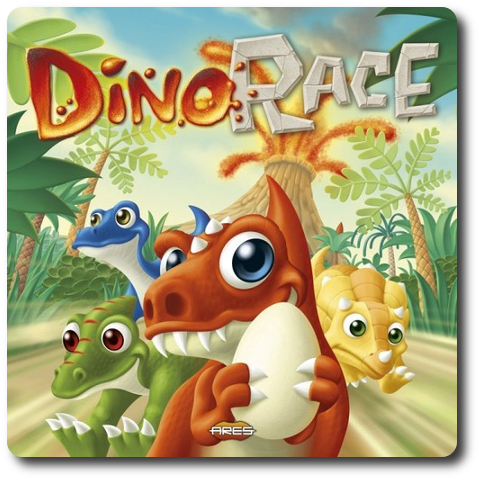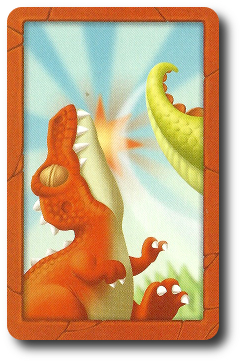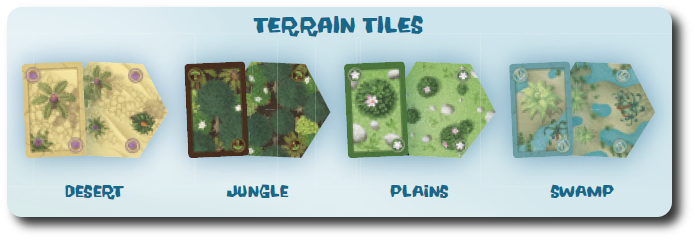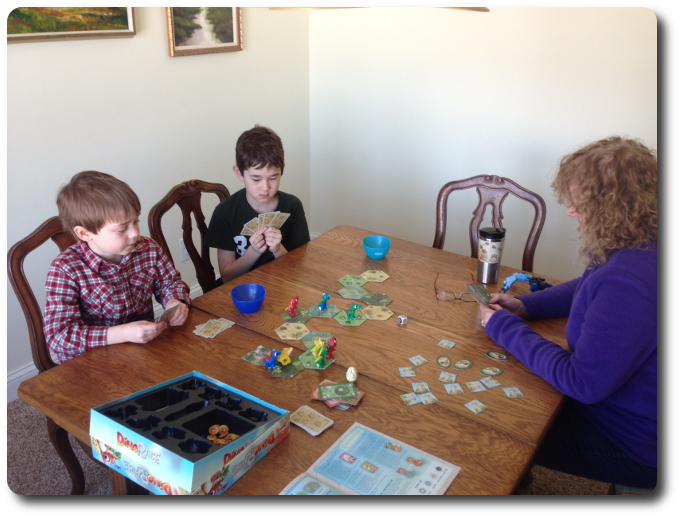
The Basics:
- For ages 5 and up (publisher suggests 6+)
- For 2 to 4 players
- Approximately 20 minutes to complete
Geek Skills:
- Active Listening & Communication
- Counting & Math
- Logical & Critical Decision Making
- Pattern/Color Matching
- Risk vs. Reward
- Cooperative & Team Play
- Hand/Resource Management
Learning Curve:
- Child – Easy
- Adult – Easy
Theme & Narrative:
- Help your little dinosaurs break the Jurassic land speed record
Endorsements:
- Gamer Geek rejected!
- Parent Geek mixed!
- Child Geek approved!
Overview
Paleontologists have not discovered anything to suggest that dinosaurs had an advanced culture. No evidence of buildings, cell phones, or hot dog stands from the time of the dinosaurs have been found among the fossilized remains. Another question yet to be answered is if the dinosaurs played organized sports. In this game, you get to participate in one of the oldest sporting events in the pre-history of the world.
Dino Race, designed by Roberto Grasso and published by Ares Games, is comprised of 12 Terrain tiles (double-sided), 1 Volcano tile (double-sided), 40 Movement cards, 12 Special Action cards, 8 Dinosaur miniatures (in 4 different types, 2 per type), 1 Dinosaur Egg miniature, 1 custom six-sided Event die, 4 Egg counters, 12 Prize counters, and 22 Lava Drop tokens. The tiles, counters, and tokens are all made of solid cardboard and are durable. The Movement and Special Action cards are as thick and as durable as your standard playing card. The Dinosaur and Dinosaur Egg miniatures are spectacular. Large, detailed, and with just enough weight to make certain they stay on the table when the player places them on the tiles.

Pre-Race Game Set Up
To set up the game, first find and place the Volcano tile. Make certain the “quiet” side (the one without lava spewing forth) is face-up. The racetrack will be built off of this tile. Make sure there is enough room in the playing area to fit the remaining 12 tiles.
Second, shuffle the 12 Terrain tiles and then place them so that each of the Terrain tiles are adjacent to only one other Terrain tile, terrain side face-up. The first Terrain tile should be adjacent to the Volcano tile. The next Terrain tail should be adjacent to the first Terrain tile placed. You are essentially creating a path with each Terrain tail representing a “step” in that path. Feel free to make the path twist and turn, but not double back on itself. Continue to place the Terrain tiles until all 12 are on the table.

Example of on possible race track configuration
Third, have each player select a pair of Dinosaur miniatures. The pair should be the same color (red, yellow, blue, and green) and be the same dinosaur type. Each player places 1 of their Dinosaur miniatures on the first Terrain tile adjacent to the Volcano tile and their second Dinosaur miniature on the second Terrain tile.
Fourth, shuffle the Movement and Special Action cards together to form 1 draw deck. Deal 5 cards to each player, face-down, and place the remaining cards face-down to one side of the game playing area. I suggest you make 1 player the “Card Dealer” for the duration of the game, as it will help the game move at a brisk pace. Leave room next to the draw deck for a discard pile.
Sixth, draw a random number of Prize counters equal to the number of Dinosaur miniatures in the race. For example, if playing a 3-player game, the total number of Dinosaur miniatures would be 6. Using this number, 6 Prize counters would be randomly drawn. Leave the Prize counters face-down, making sure to randomize them again if any values were shown when they were drawn. Any Prize counters not drawn remain in the game box and should stay hidden.
Seventh, place the Event die and the 4 Egg counters to one side of the game playing area, but within easy reach of at least 1 player.
That’s it for game set up. Determine who the first player will be and give them the Dinosaur Egg miniature. Time to race some dinosaurs!
Dinos, Start Your Engines!
Dino Race is played in turns with no set number of turns per game. A player’s turn is broken down into 3 sequential steps. A typical player’s turn is summarized here.
Step 1: Draw Cards
The first thing a player does is draws 1 card per Dinosaur miniature they still have on the Terrain tiles. These cards are added to any other cards in the player’s hand.
If the draw deck should run out, shuffle the discard pile and turn is face-down to create the new draw deck.
Step 2: Play and Swap Cards
There are 2 types of cards. The first are Special Action cards that give an advantage during the race and the Movement cards that move a player’s Dinosaur miniature forward.
Special Action Cards
Special Action cards can be played at anytime during this step of the player’s turn. This means Special Action cards can be played before any Movement cards, between Movement cards, or after all Movement cards have been played. It’s up to the player to determine when they should be played and against whom. After Special Action cards are used, they are discarded.
The “Push Back” Special Action card allows the player to target 1 opponent Dinosaur miniature currently occupying the same Terrain tile as a player’s Dinosaur miniature and move it back 1 Terrain tile towards the Volcano tile. Pushing an opponent’s Dinosaur miniature back onto a Lava tile is permissible, but the opponent’s Dinosaur miniature won’t move from the tile it’s currently occupying. Instead, the opponent will receive 1 Lava token.
The “Throw the Egg” Special Action card does one of two things. If the player currently has possession of the Dinosaur Egg miniature, playing the card allows them to give the Dinosaur Egg to any opponent who has a Dinosaur miniature currently occupying the same Terrain tile as a player’s Dinosaur miniature. If the player does not have the Dinosaur Egg miniature and uses it against an opponent who does, they take the Dinosaur Egg miniature. The opponent then tips over their Dinosaur miniature, indicating that it has been pushed over. To stand the Dinosaur miniature back up and move it, the opponent will need to discard any 2 cards from their hand on their next turn.

The “Steal a Card” Special Action card allows the player to take 1 card from any opponent’s hand. The player does not get to see what card they take and must draw 1 card at random from the opponent they select.

Movement Cards
Each Movement card will show 1 terrain type. Specifically, desert, jungle, plains, or swamp. In order to move, the player must play a Movement card that matches the terrain type of the Terrain tile the player wants to move their Dinosaur miniature onto. A Dinosaur miniature can only move forward 1 Terrain tile at a time, so each Movement card must match the terrain type of the next Terrain tile in the race track path. The player can move one or both of their Dinosaur miniatures, but each Movement card can only move 1 Dinosaur miniature at a time. That is, if both Dinosaur miniatures were in front of a “Swamp” Terrain tile, the player would have to play 2 “Swamp” Movement cards to move both.

If the player is unable to play the exact terrain type, they can combine 3 Movement cards of the same terrain type and discard them. For example, 3 “Swamp” Movement cards would allow the player to move their Dinosaur miniature to a “Desert”, “Jungle”, or “Plains” Terrain tile. There is also a “Wild” Movement card that depicts all 4 terrain types. The “Wild” Movement card can be used as any terrain type.
Swap Cards
If the player doesn’t have any cards they want or can play, they can swap them out. This is done by discarding any 2 cards in the player’s hand (player’s choice) and drawing 1 new card from the draw deck. A player can swap cards anytime they like during their turn. Before playing cards, during, and after. There is also no limit to the number of times the player can swap. As long as they have enough cards, they can continue to swap out what they don’t want in hopes of getting cards that might help.
Step 3: Roll Event Die
After the player has played and swapped out any cards they like, they take the Event die and roll it in front of all the players. The next action taken is dependent on what is rolled.

Terrain
If any of the 4 terrain type symbols are rolled, each player gets to draw 1 card per Dinosaur miniature currently occupying the same terrain type as the one on the Event die. For example, if a player had 2 Dinosaur miniatures on a “Swamp” Terrain tile, and “Swamp” was rolled on the Event die, the player would draw 2 card.
Two Cards
If the Two Cards symbol is rolled, each player gets to draw 2 cards.
Eruption
If the Eruption symbol is rolled, things start to heat up. If this is the first time the Eruption symbol as been rolled, the Volcano tile is flipped over to reveal a massive eruption of lava, rock, and certain doom. On the second and subsequent rolls of the Eruption symbol, the next closest Terrain tile to the lava flow is flipped over revealing more lava. In this way, the race track turns into a big lava flow that is hot on the dinosaurs’ heels! If any Dinosaur miniatures are on a Terrain tile that is flipped over to the lava side, the Dinosaur miniatures are moved to the next closest Terrain tile and each player receives 1 Lava Drop token for each Dinosaur miniature caught by the lava flow, as well as discarding 1 card from their hand.
Additionally, the player who currently has possession of the Dinosaur Egg miniature must discard all their cards and takes 1 Lava Drop token. The Dinosaur Egg miniature is then passed to the next player in turn order sequence.
This completes the player’s turn. The next player in turn order sequence now goes starting with step 1 noted above.
Finishing the Race and Ending the Game
Dinosaur miniatures placed onto the last Terrain tile have completed the race and no longer have to fear the lava or being the target of attacks. The Dinosaur miniature is removed from the last Terrain tile and is out for the duration of the game.
The player then takes all the Prize counters not yet claimed, looks at them, selects 1 to keep, and then places the remaining Prize counter tokens face-down without showing opponents the Prize counter token values. This is the player’s prize for completing the race and it should be kept hidden until the end of the game.
Finishing the race with both Dinosaur miniatures allows the player to draw a total of 2 Prize counters. Any cards still in their hand are discarded. The player might be out of the race, but they are not out of the game. On their turn, they roll the Event die, skipping any actions that allow them to draw cards. The die result rolled, however, impacts all the players still in the race.
If the player who has possession of the Dinosaur Egg miniature finishes the race with their second Dinosaur miniature, they draw Prize counters and discard cards as normal, but they also get to draw 1 Egg counter. This counter is chosen at random and kept hidden like just like the Prize counters.
The game ends as soon as the player who has possession of the Dinosaur Egg miniature finishes the race with their second Dinosaur miniature. Any Dinosaur miniatures still on the race track are disqualified. They won’t cost their owners points, but they won’t be earning any points, either.
Final Score
Once the race comes to an end, players reveal their Prize and Egg counters. The number values on the counters are added together. Then the player’s reduce their counter total by -1 for every Lava Drop token they collected. An additional +3 points is awarded to the player who collected the Prize counters with the same color. The resulting number is the player’s score for the race. The player with the highest score wins the race and the game!
Game Variants
There are a few game variants available to spice things up and allow more friends to play.
Survive!
This game variant removes the Prize counters, the Dinosaur Egg miniature, the Egg counters, and the Lava Drop tokens. This is a great game variant for the youngest of Child Geeks, as it allows them to focus only on the race. I personally found this game variant very boring, but I’m speaking as an adult here.
Double Match
If one race is not enough, and you’re pretty sure the player who won might have a magical rabbit’s foot for good luck, 2 games can be played back to back. After the second race, take the sum of both final scores. The player with the highest score wins. You could do 3 or even 4 races back to back, too, if you like, but that would be overkill.
Team Play
Each pair of Dinosaur miniatures has a slight color variation that allows you to visual distinguish the difference between the two. This allows for team play, with 2 players taking 1 Dinosaur miniature each of the same color and then working together as a team during the race. Team members can pass cards back and forth in secret, discuss strategy, and share in the victory. Game play is more or less the same, meaning teams have to hustle to win. The best part of this game variant is that allows up to 6 and 8 players!
To learn more about Dino Race, visit the game’s web page.
Final Word
The Child Geeks were in love with Dino Race right out of the box. The colorful and well sculpted baby dinosaurs were passed around and examined by each player before the game could begin. The Child Geeks were excited about the idea of a volcano blowing up and lava chasing them through the race course, but didn’t like the idea that their dinosaurs could get hurt. According to one Child Geek, “I think the lava adds a great reason to run like crazy!” All the Child Geeks quickly learned and mastered the game play, finding the rules and game flow to be very straightforward. The only aspect of the game they disliked was the Event die. As one Child Geek put it, “Where is the lava? I want that volcano to explode!” Out of all our games, the volcano only exploded a few times and the lava never chased the dinosaurs more than a few tiles. This was a great disappointment to the Child Geeks, but they still had a good time. When the dinosaurs were safely across the finish line, the Child Geeks gave Dino Race two big thumbs up.

Two Child Geeks teach their nana how to race, dinosaur style
The Parent Geeks enjoyed themselves when playing Dino Race with their Child Geeks and were much less enthused when playing only with Parent Geeks. According to one Parent Geek, “I think this is a great game for my family and it’s a lot of fun to play with the kids, but man, not a great game for adults.” Another Parent Geek said, “The only aspect of the game I do not like is the Event die. It injects an unnecessary level of randomness, I think, into a game that already makes use of critical thinking and hand management. I mean, why do that?” All the Parent Geeks loved the game components and liked how each race was as difficult as the last, but never to a point where it could not be won, or at the least, finished. A few of the Parent Geeks thought the game lasted a bit longer than it should at times and even more Parent Geeks felt that the lava should have played a bigger role. When the games were over, the Parent Geeks voted to approve Dino Race for families, but rejected it for casual play among adults.
The Gamer Geeks did not care for this game, which is not surprising when we consider that Dino Race was a game designed for Child Geeks. According to one Gamer Geek, “It’s a good enough game for the kids and families with young kids, I suppose.” Another Gamer Geek said, “I like the concept, but think using the die was a big mistake for the lava. The lava flow is positioned to be a major part of the game play, but its appearance and progression is completely random.” All the Gamer Geeks voted to reject the game play, but applauded the game component quality.
The players had an interesting debate during each of the games. Some believed the Dinosaur Egg miniature was worth the risk of holding so as to get more points. Others thought the egg was nothing more than a red herring designed to make the players believe they were taking a risk when they really weren’t. In some respects, I think both groups are correct. Taking on the Dinosaur Egg means you will suffer more than the other players when – and if – an Eruption is rolled. However, if the player is able to finish the race with the Dinosaur Egg, they might get just enough bonus points to win. On the other hand, victory almost always went to the player who finished first and second in the race because they always selected the Prize counters worth the most points. But hold your horses because here is where I think the Dinosaur Egg miniature trumps this argument. If you can finish the race with your second Dinosaur miniature before the majority finish their first or second Dinosaur miniature, you lock all of those players out of the race. You greatly increase your odds of winning as a result. How much? Who can say, but it’s enough of a proverbial carrot to have made the Dinosaur Egg miniature a desirable burden to carry.
My biggest complaint about this game is the Event die used to trigger the volcano eruption. I greatly dislike it. I would have preferred that the draw deck be randomly seeded with 13 Eruption cards that cause the eruptions to happen throughout the course of the game. That way you know there will always be lava and swapping cards becomes a bit of a gamble. Mathematically speaking, there is always a 1 in 6 (or 16.667%) chance of rolling the Eruption. Those odds are not great. Worse of all, those odds never change. I have played 3 games where the Volcano never erupted at all. In all the games I observed (by my count, around 12), I have only seen a maximum of 5 Terrain tiles flip to lava. This leads me to believe, and I think my observations back me up on this, that the element of danger in Dino Race is there, but it’s not a great threat. It hangs over your head throughout the game as a possibility, but the probability of it occurring is slim.
Dino Race was a big dude for the Gamer Geeks and half the Parent Geeks, but loved by the Child Geeks. This is a pretty good game for the younger Child Geeks, too, teaching them the basics of hand management, worker placement, and critical thinking. Make no mistake, the game is very forgiving and can tend to feel exceedingly random, but the game also gives all of the decision making power to the player with no strings attached. Add in the threat of lava, light player conflict, the need to move as fast as you can, as well as the risk versus reward with the Dinosaur Egg miniature, and you have a game that is setting up your Child Geek for bigger and more complicated games to come. The lessons they learn in Dino Race will serve to strengthen their game play in the future, while entertaining them and their families in the process.
This game was given to Father Geek as a review copy. Father Geek was not paid, bribed, wined, dined, or threatened in vain hopes of influencing this review. Such is the statuesque and legendary integrity of Father Geek.
Discover more from Father Geek
Subscribe to get the latest posts sent to your email.





